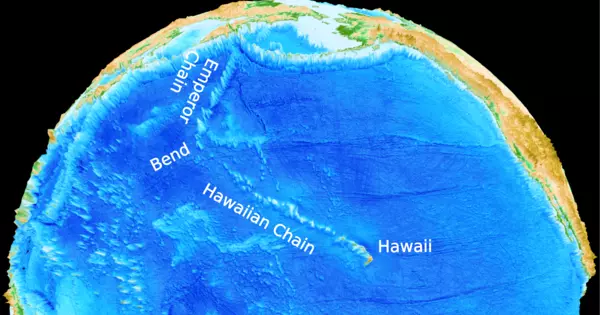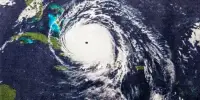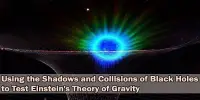To quantify the amount of Pacific Plate motion change associated with the Hawaiian — Emperor Bend, kinematic plate reconstructions and high-resolution global dynamic models were developed. Scientists hope that this fundamental research into Pacific Plate motion can be applied to other related phenomena like large earthquakes.
The Hawaiian-Emperor seamount chain stretches nearly 4,000 miles from the Hawaiian Islands to the Detroit Seamount in the north Pacific, forming an L-shaped chain that goes west then abruptly north. Scientists have been perplexed by the 60-degree bend in the line of mostly undersea mountains and volcanic islands since it was discovered in the 1940s using data from numerous echo sounding ships.
A group of scientists has now used supercomputers provided by the Extreme Science and Engineering Discovery Environment (XSEDE) to model and reconstruct the dynamics of Pacific tectonic plate motion, which could explain the enigmatic mountain chain bend.
Significant Findings
“We’ve demonstrated for the first time with computer models how the Pacific plate can abruptly change direction from north to west,” said Michael Gurnis, professor of Geophysics at the California Institute of Technology. “Determining why this change occurred has been a holy grail,” he said. Gurnis was a co-author on a study that was published in Nature Geoscience in January 2022 on the origins of the seamount chain.
We’ve demonstrated for the first time with computer models how the Pacific plate can abruptly change direction from north to west. It’s a new hypothesis that’s much firmer in terms of the physics which it’s based upon. It will allow other scientists to see if it will hold up to further scrutiny and if there are other ideas that can be tested on its assumptions.
Prof. Michael Gurnis
Plate Motion Clues
The plate motion reveals how the seamount chain reflects plate motions. Massive tectonic plates in the Earth’s crust basically move over the hot, weak rock of the mantle. The Pacific Plate is one of the largest. The plate spans approximately 40 million square miles beneath the sea, outlined by the mountains and volcanoes of the ‘Ring of Fire,’ which are formed by the return of the plates to the mantle.
However, this process did not result in the Hawaiian volcanoes or the Hawaiian-Emperor seamount chain. Instead, scientists believe that plumes of Earth’s hottest rock travel upward through the mantle to create a volcanic hotspot. And it’s theorized that the seamount chain was created by the plate moving over the hot plume, something like a trail of burn marks on a paper moved over a candle.
About 80 million years ago, the Pacific plate traveled mostly north for about 30 million years, as evidenced by the line of Emperor seamounts. But about 50 million years ago, something odd happened. The Pacific plate apparently changed direction, and the mantle plume also shifted.
“Maybe there’s an underlying physical reason why they would happen simultaneously,” Gurnis said.

Prior Gordon Bell Prize
He cited previous work on the dynamics of mantle convection using techniques such as adaptive mesh refinement, computational work that scales well to a large number of CPUs and used the TACC Stampede1 system, which earned the team led by Johann Rudi the Gordon Bell Prize in 2015.
“Moreover, previous work with Mu?ller, Gurnis, and others demonstrated how plume physics could work inside the mantle such that you could have a plume that rapidly migrated to the south and then stopped at 50 million years ago,” Gurnis said.
“These two studies are complementary because going into the present study, we actually had a model which could explain the motion of the plume to the south and then stop abruptly, but we didn’t have a model that could explain how the plate could change its direction,” he added. The team’s computations of the physics of tectonic plates had to account for the faults at their boundaries but yet allow the movement of plates.
Computational Challenges
The difficulty in computing both pieces of physics at the same time meant that they needed computational methods that could handle large differences in mechanical properties from one plate to the next, as well as faults.
However, the traditional ideas of plate motion in the models did not add up to enough force to pull the Pacific Plate to the west and explain the bend. “We discovered another idea that had existed in the literature, but it wasn’t getting much attention,” Gurnis explained.
New Factor
The study’s new factor was a subduction zone in Russia’s Far East, a Kronotsky arc that ended about 50 million years ago. They used these subduction zones to create new plate tectonic reconstructions.
They discovered that by putting the zones into the models, they could make the Pacific plate move to the north. When that subduction zone ended, the Pacific plate began to move west, gradually forming other subduction zones that provided more force to pull the Pacific plate over time.
“It’s a new hypothesis that’s much firmer in terms of the physics which it’s based upon,” Gurnis concluded. “It will allow other scientists to see if it will hold up to further scrutiny and if there are other ideas that can be tested on its assumptions.”
















